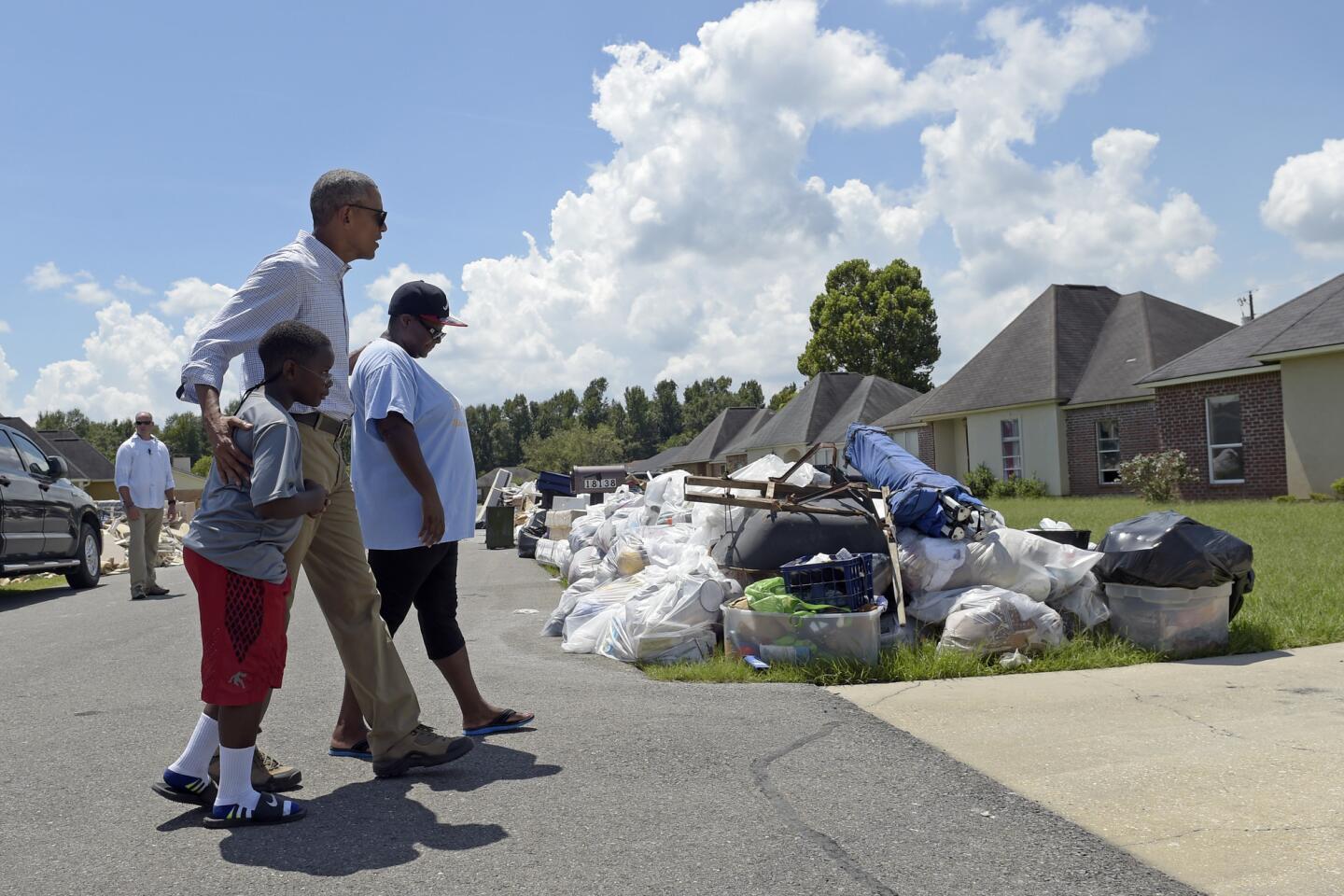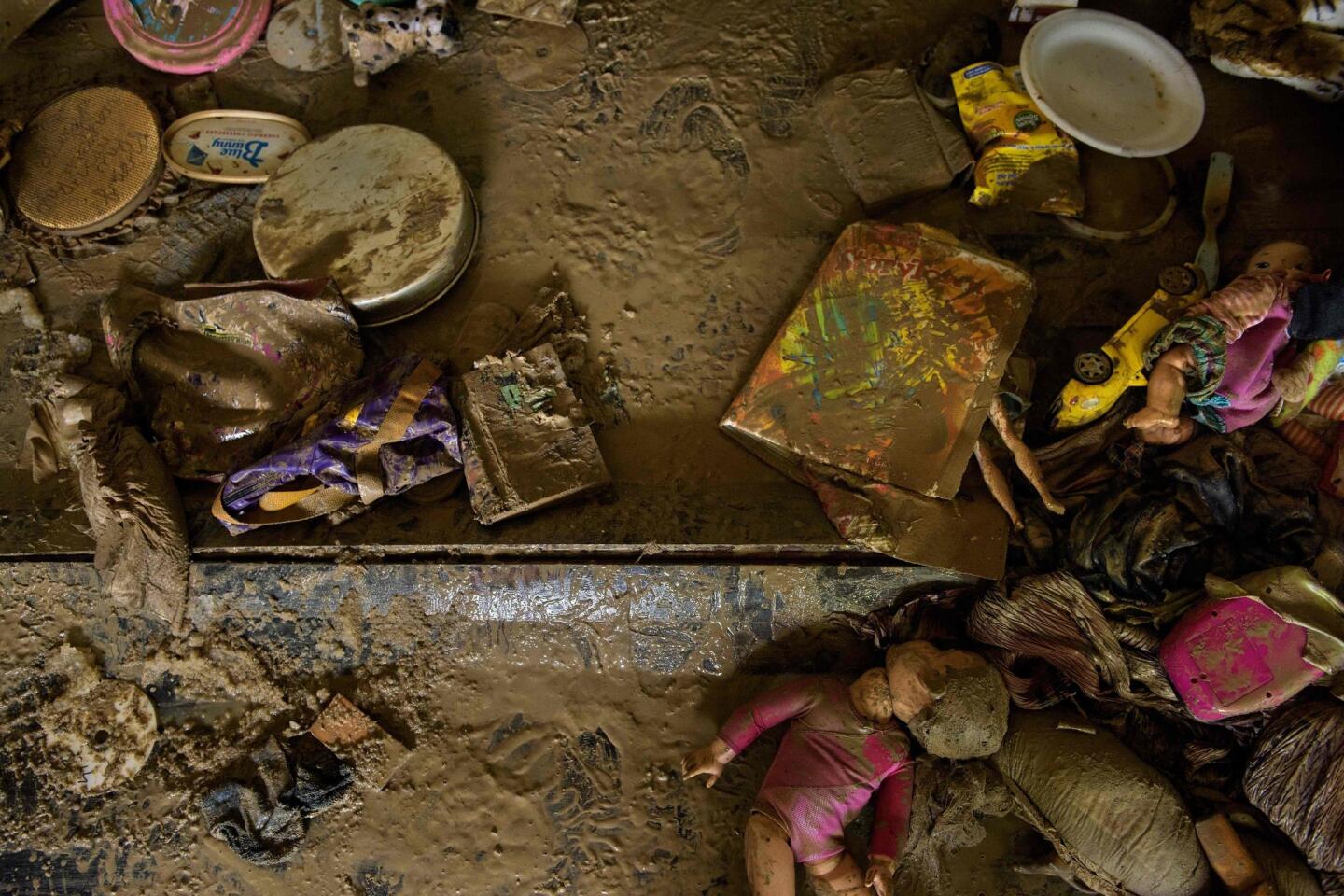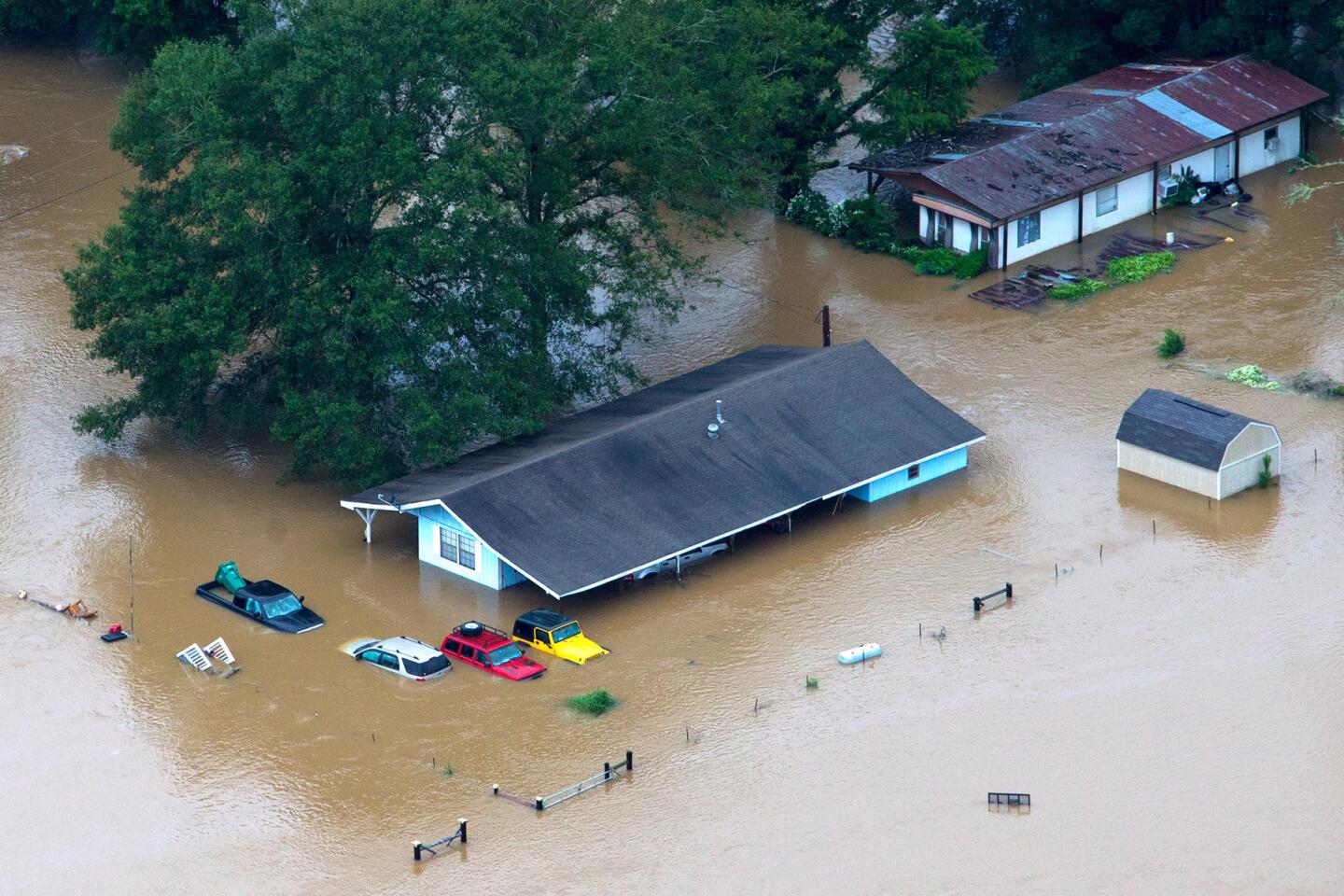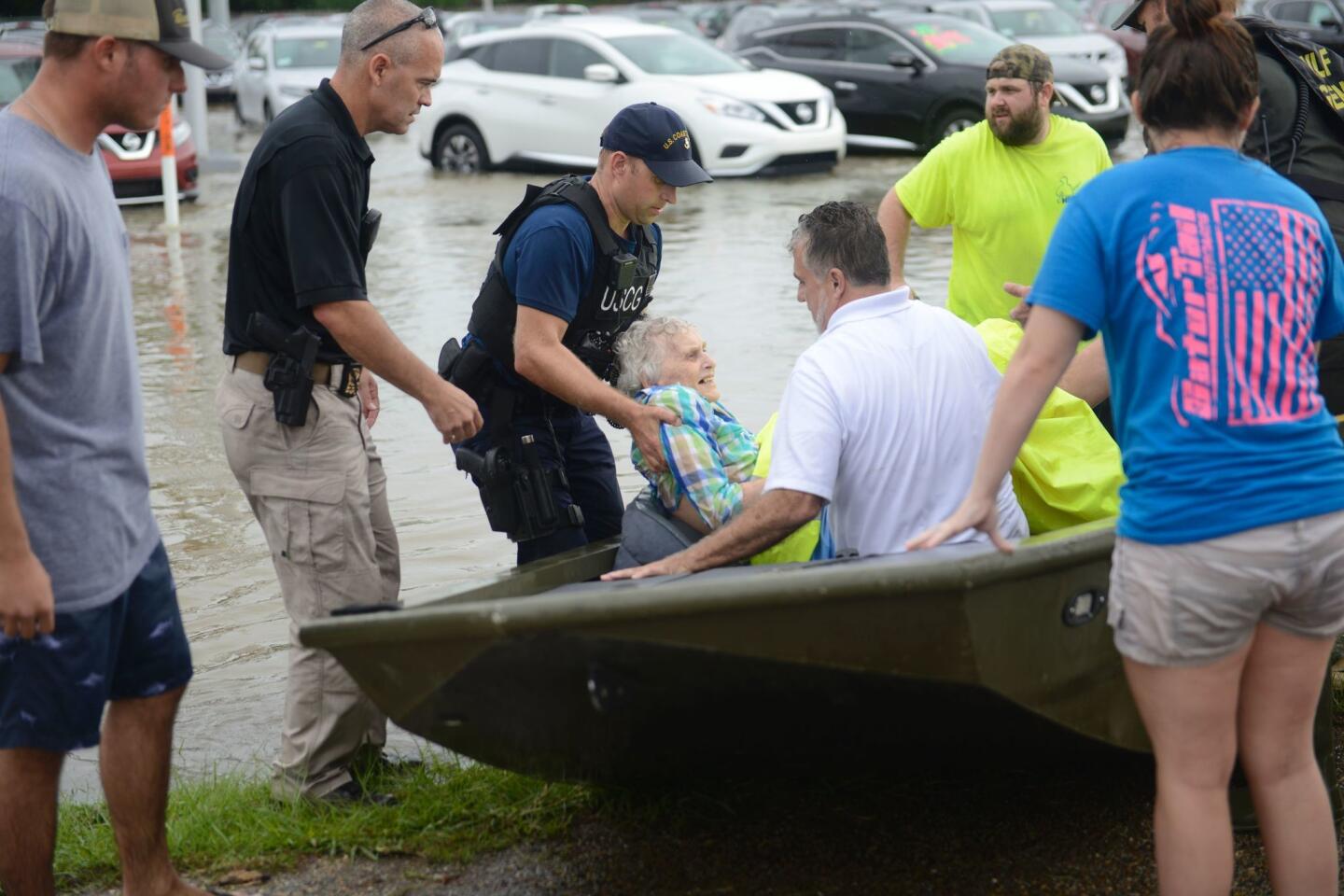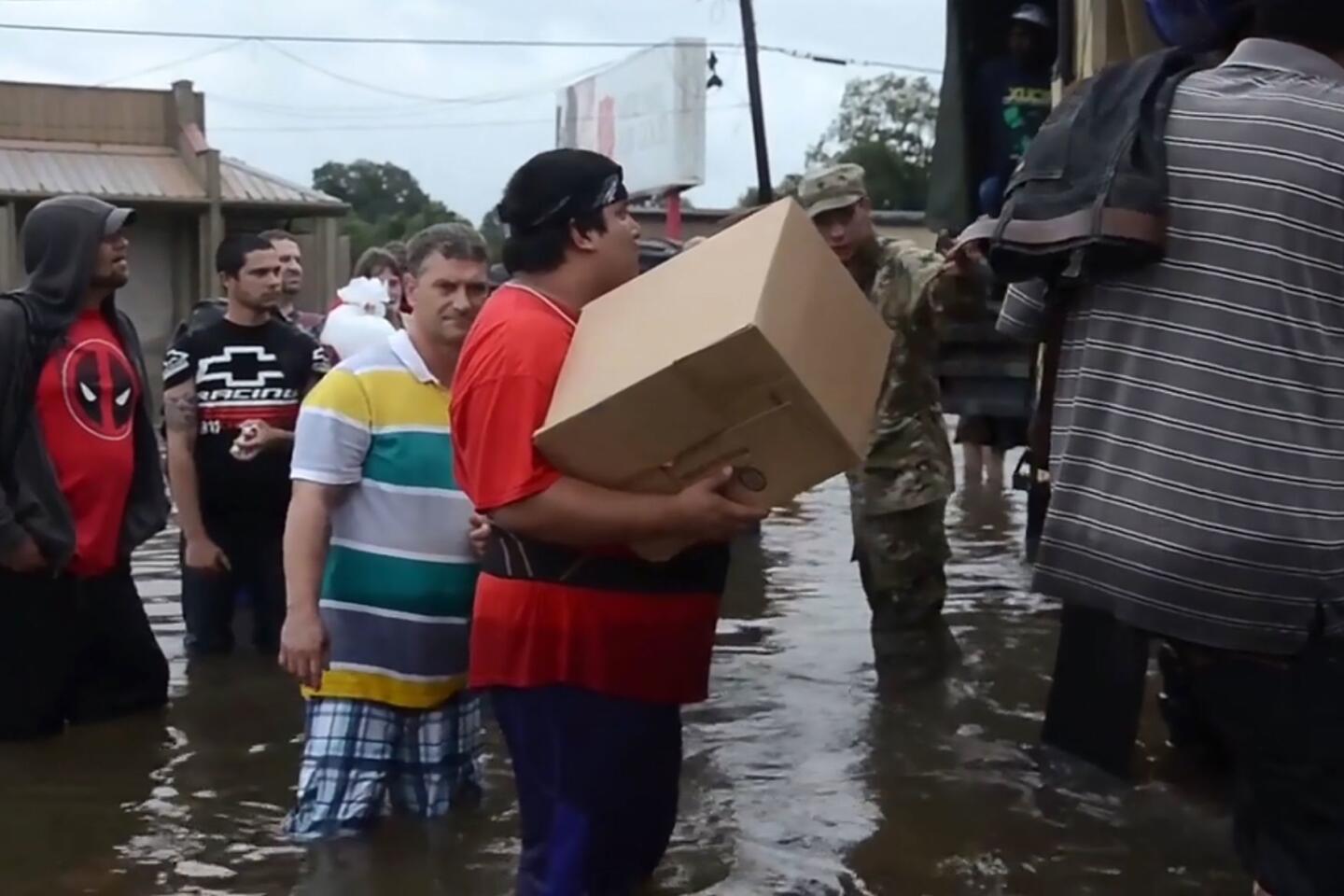Historic flooding kills 8 in Louisiana as thousands scramble for safety

Dramatic Rescue Caught On Camera In Louisiana
Reporting from Atlanta — More than 30,000 people have been rescued as torrential rain caused dangerous flooding across southern Louisiana, engulfing entire neighborhoods and transforming them into vast pools of brown, murky water.
As rivers across the state burst their banks, submerging thousands of homes, more than 12,000 people took refuge in 70 shelters. The death toll rose to eight on Monday.
Water seeped into communities that had never flooded before. In the suburbs of Baton Rouge, fishing boats sailed down once-bustling streets and highways, past empty ranch homes and stores with water up to their doors, windows and, in some cases, roofs.
Volunteers, firefighters and National Guard soldiers rescued people from the tops of houses and cars, and even plucked them from trees.
In Hineston, a small town in central Louisiana, Jeanette Thacker and her daughter, Jessica, were out walking along a quiet country road Sunday, checking out the water levels near a local creek, when they heard screams.
Jeanette Thacker, 45, decided to investigate, not sure if a cat was crying, kids were playing or someone was in trouble. At first the water was ankle-deep. The mother and daughter held on to each other as the water climbed past their rain boots. Soon they were wading in waist-deep water — and it was clear they were listening to a child’s screams.
A quarter of a mile down the road, they found a boy, about 3 or 4 years old, hanging from a small tree.
“When I swam to him, his first words were, ‘My grandmother is dead,’” Thacker said.
The boy’s grandmother’s body was submerged in water, face down, except for her head and one shoulder. Thacker swam to the tree and held the boy for about 30 minutes while her daughter went to get help. Eventually, Thacker’s father and the volunteer fire department drove a boat out to rescue the boy, and he was taken by ambulance to a hospital.
In a region long acquainted with formidable hurricanes, the summer rainfall caught many Louisiana residents and officials off guard.
“At least with a hurricane you see it coming,” said Col. Edward Bush, a spokesman for the Louisiana National Guard. “This was nothing but a summer thunderstorm.… Certainly, we had no time to prepare for this.”
Rescue efforts peaked Sunday, Bush said, with the Louisiana National Guard mobilizing 3,300 members. As of Monday, it had rescued 7,600 people and more than 1,000 pets. One of its most remarkable rescue efforts came late Sunday when the Woman’s Hospital in Baton Rouge, one of the only facilities in the region to offer intensive care for newborns and infants, risked imminent flooding.
Engineers worked into the early hours of Monday morning to surround the sprawling brick facility with an Aqua dam — an inflatable black, polyethylene tube filled with water that essentially served as a six-foot levee, protecting the hospital from rising floodwater from a nearby bayou.
“Evacuating a hospital is a very significant task, a worst-case scenario,” Bush said. “Fortunately, we were able to figure out how to avoid that.”
Across the state, more than 1,000 homes were damaged in the parish of East Baton Rouge; another 1,000 in Livingston, 28 miles east of Baton Rouge; and hundreds more in other parishes, said Mike Steele, communications director for the Louisiana Governor’s Office of Homeland Security & Emergency Preparedness.
On Monday, Devin George, the state registrar for vital records at the Louisiana Department of Health, confirmed the drowning deaths of a woman in Tangipahoa Parish as well as a woman and a man in East Baton Rouge Parish.
Sheriff’s officials in East Baton Rouge said a 40-year-old woman was found inside a vehicle that had been swept away as she tried to turn it around in high water.
The sheriff’s office later reported that a volunteer navigating Baton Rouge in his boat had found a deceased man in front of the Greenwell Springs Road Regional Branch Library.
President Obama granted Louisiana an initial disaster declaration Sunday, freeing up federal aid for the parishes of Tangipahoa, St. Helena, East Baton Rouge and Livingston. By Monday evening, more than 36,000 people had registered for Federal Emergency Management Agency aid.
Gov. John Bel Edwards toured flood-damaged areas in southwestern Louisiana by helicopter Monday, sweeping over flooded high schools, shopping malls and farmland to meet with local emergency officials in Lafayette, Ascension and Vermilion parishes.
“Our state is currently experiencing a historic flooding event that is breaking every record,” Edwards said in a statement. “This event is ongoing, it is not over. Even if the sun has come out in your area, we do not know when the floodwaters will recede, and they will continue to rise in some areas.”
Heavy rainfall also deluged parts of southwestern Mississippi, damaging 74 homes, destroying five county roads, and causing Gov. Phil Bryant to declare a state of emergency for several counties. On Monday, 85 people were staying at a shelter in Natchez, while another 100 stayed in hotels or with family, said Greg Flynn, a spokesman for the Mississippi Emergency Management Agency.
As many as 40,000 businesses and homes in Louisiana were without power. As hundreds of roads remained closed, navigating roadways to avoid flooded areas was exacerbated by communications failures.
The National Weather Service reported that more than half a dozen river gauges have set new record highs in southeast Louisiana. In Magnolia, the Amite River crested at more than 58.56 feet, topping the previous 1977 record by more than six feet.
Edwards has called the flooding “unprecedented,” yet only five months ago Louisiana grappled with another bout of record rainfall. In March, record flooding was observed on five river gauges across the state, with almost 27 inches of rain falling southeast of Monroe in three days.
In 2005, the state experienced the costliest natural disaster in the history of the United States, when thousands of homes in New Orleans and along the Gulf Coast were flooded after Hurricane Katrina swept inland, breaching New Orleans’ levees and killing more than 1,800 people across Louisiana and Mississippi.
Jarvie is a special correspondent.
ALSO
Courts urged to strike down election maps that lock in the winners
How our methods for fighting mosquitoes have changed over the years
Who owns the wind? We do, Wyoming says, and it’s taxing those who use it
UPDATES:
8:25 p.m.: Updated with a new death toll of eight and additional details.
6:05 p.m.: Updated throughout with new details.
11:30 a.m.: Updated with additional reporting.
10:03 a.m.: Updated throughout with Times reporting.
8:47 a.m.: Updated with six dead and details throughout.
This post was originally published at 6:05 a.m.
More to Read
Sign up for Essential California
The most important California stories and recommendations in your inbox every morning.
You may occasionally receive promotional content from the Los Angeles Times.


